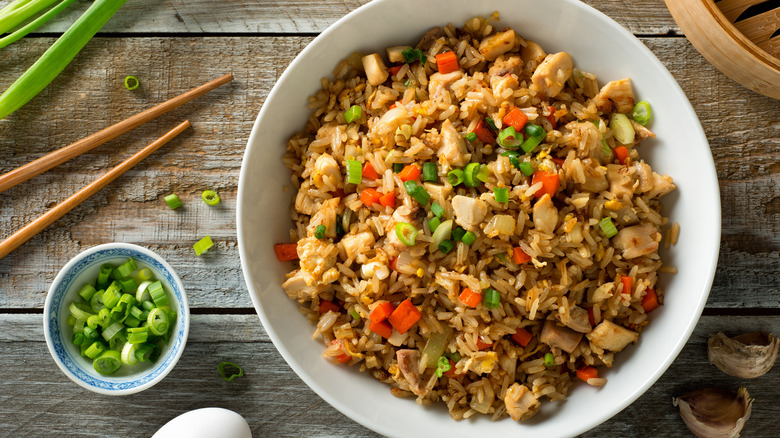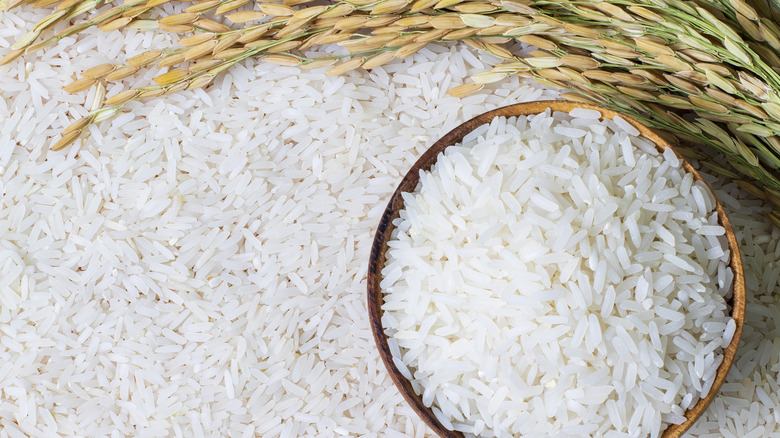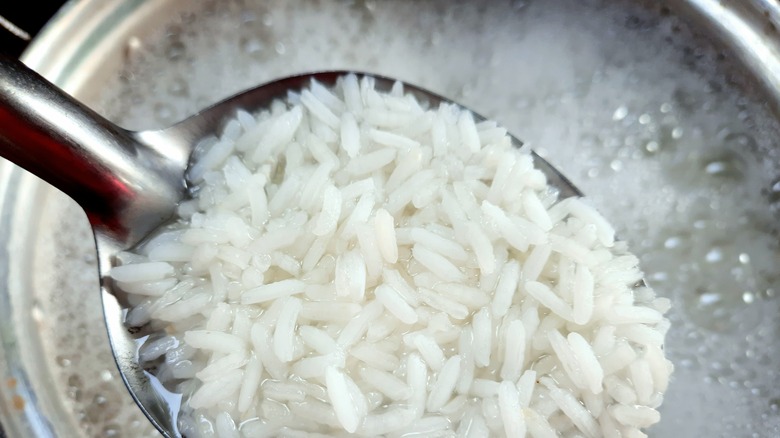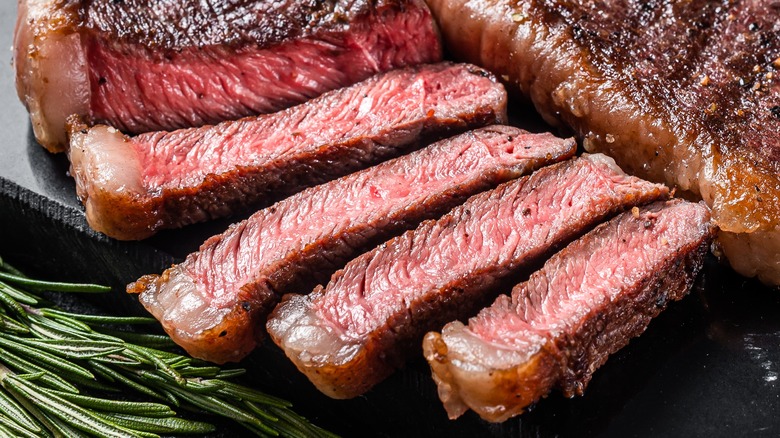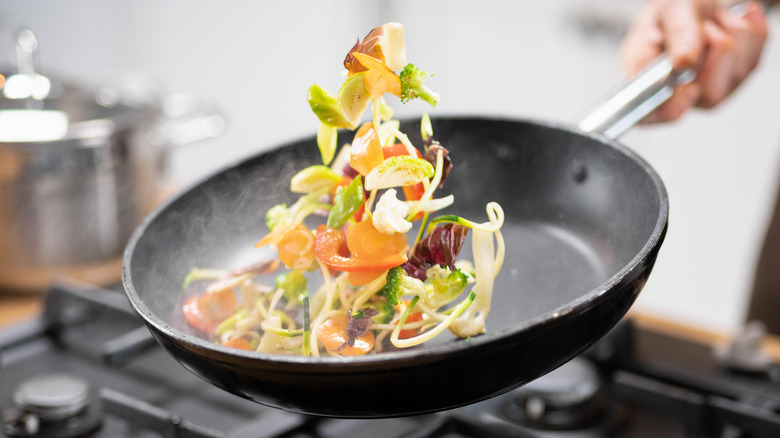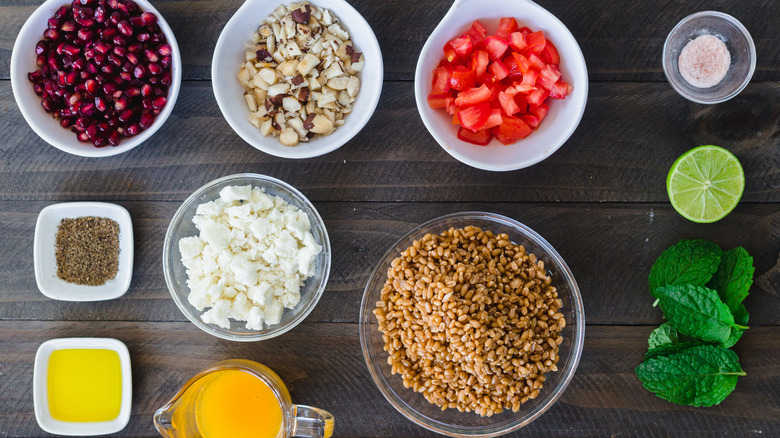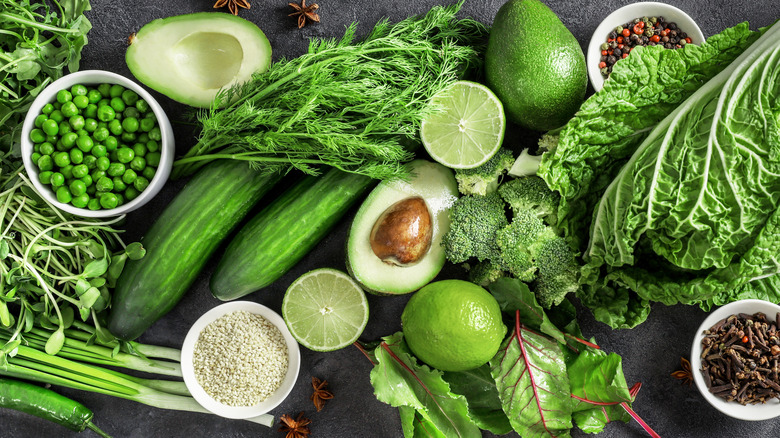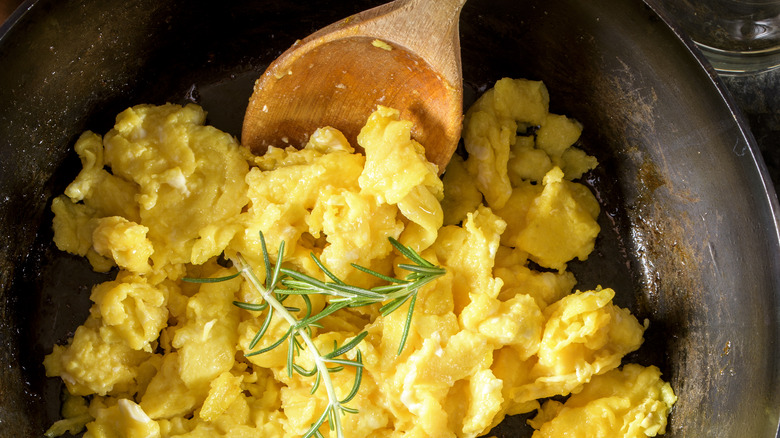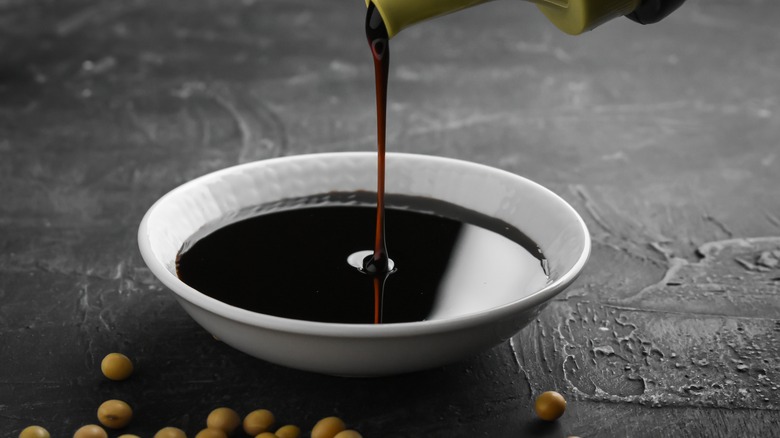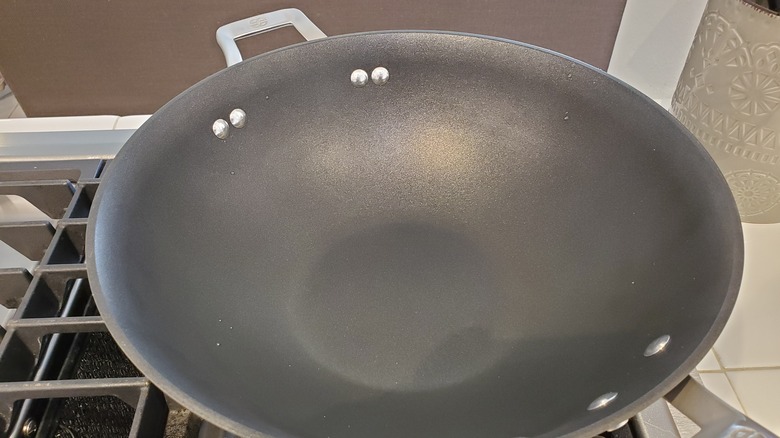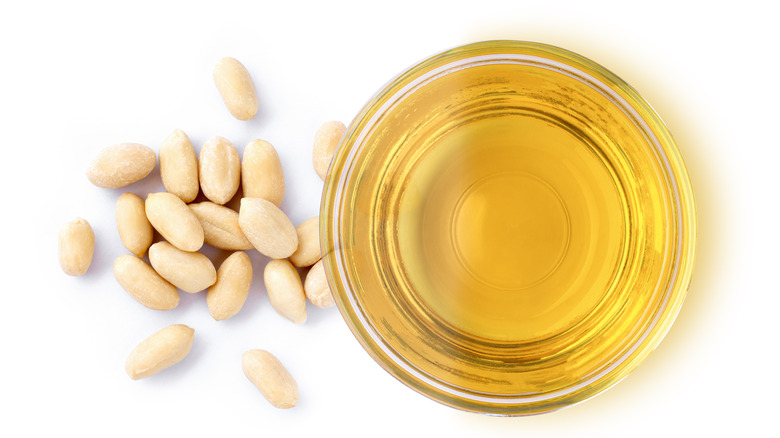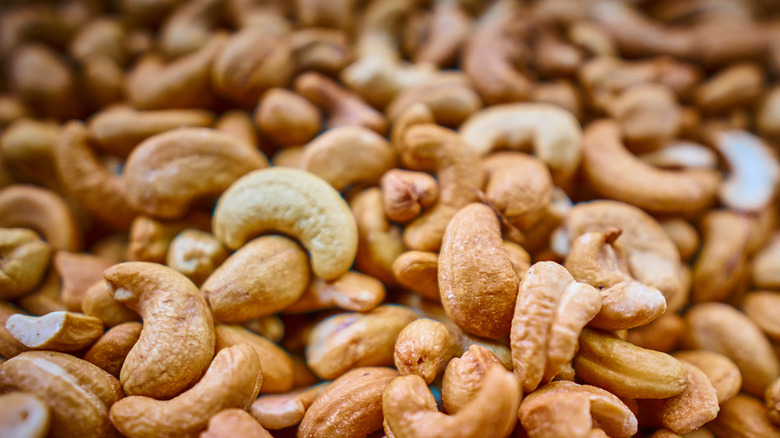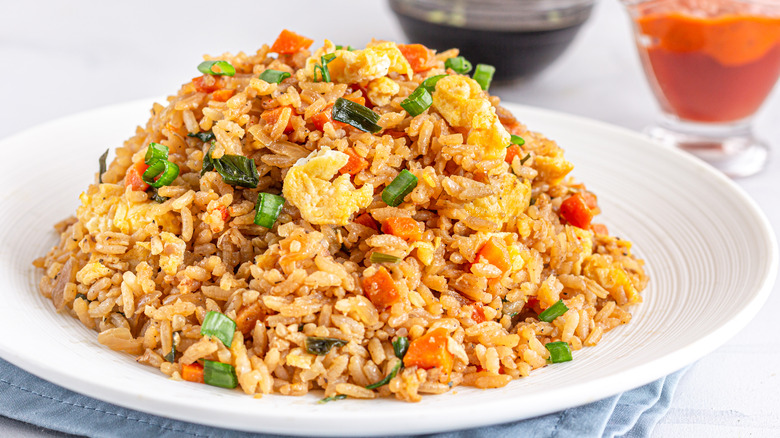12 Tricks For Making Seriously Delicious Egg Fried Rice At Home
When you're tired or stressed out and need something comforting to help you unwind, there's nothing quite as delicious or satisfying as a good bowl of egg fried rice. Typically made from a mixture of cooked rice, eggs, garden veggies, and proteins like chicken, pork, or shrimp, egg fried rice is a simple and hearty dish that can be enjoyed as a meal or snack, anytime of the day or night.
While the dish got its start in China, egg fried rice is now beloved around the globe not just because it's so tasty and filling, but also because it's convenient and easy to prepare. It can be customized in an almost infinite number of ways — loaded with meat; packed with bok choy, spinach, mushrooms, and bean sprouts; or used as a showcase for oyster sauce, hoisin sauce, fish sauce, and more. The only thing almost everyone who loves egg fried rice will agree on is that it has to have a harmonious balance of flavors. It has to have plenty of seasoning. And it's got to have crispness, fluffy rice, silky eggs, and that wonderful smoky, slightly charred flavor that you can only get from stir-frying food in a hot wok.
Mouth watering yet? Good! We spoke to a couple of the country's best cooking instructors to ask them how to make egg fried rice that meets all of this criteria. For their secrets on how to make the best egg fried rice of your life, keep reading.
Choose the right rice
A great bowl of egg fried rice starts with picking the right ingredients to sauté — especially the main star of the dish, the rice! According to Jazmine Hall, culinary director of the popular cooking school Taste Buds Kitchen (which has locations across the country), that means long- or medium-grain rice like jasmine rice or basmati rice, with basmati being her favorite option. "Since the rice is long and thin," she says, "it reduces the chances of the rice clumping together when being reheated."
To make incredible egg fried rice, Hall recommends always using leftover rice or cooking your rice in advance so it has time to cool. "Cold, day-old rice is the best way to go," she advises. "Using rice that has been recently made will lead to a mushy overcooked recipe that won't fry as well. Basically, at that point, you're just overcooking perfectly cooked rice — and that only works for rice puddings!"
By using cold rice, you end up both reheating and essentially toasting the rice to add more flavor and texture — two keys to a great-tasting bowl of egg fried rice, Hall says. Also, remember that while egg fried rice is versatile, you can't use just any rice to make it. "Our least favorite is short grain rice because it tends to clump together and get mushy when reheated," she cautions.
Cook your rice correctly
If you're using leftover rice from last night's Chinese food delivery to make your egg fried rice, you can't do much about how the rice was cooked — you've just got to use what's there. But if you are cooking your rice a day in advance in anticipation of making a bowl of delicious, savory egg fried rice, then the most important thing you can do is keep that rice dry, says Albert Nguyen, a chef-instructor of culinary arts at the world-renowned Institute of Culinary Education, the top rated culinary school in the country.
Like Jazmine Hall, Nguyen agrees that long grain is best for frying due to its relatively lower starch content. Rice intended for use in "fried rice should be cooked on the drier side," he adds. "By no means should the rice be raw, but your ratio of water to rice should be very tight as to result in very dry, yet fully cooked and loose grains." The drier your rice is, he adds, the looser your fried rice will be and the less likely it will develop lumps or clump together in the pan.
Don't have time to cook your rice in advance and let it sit? Or forget to cook your rice the day before? Spread it out on a cooking sheet and let it come to room temperature, Nguyen says. It's the next best thing to cold, leftover rice.
Pick the right protein
Egg fried rice offers a wonderful canvas for a wide variety of proteins. You can, of course, eat it on its own, but it's also a great vehicle for diced chicken, sliced pork, shrimp, or tofu. Chicken and pork are particularly good options to include in the dish since each can be quickly stir-fried, helping to keep the meal quick and convenient. Shrimp can provide a unique seafood twist, contributing a hint of sweetness and a delicate texture to your egg fried rice. And tofu adds more than heft and protein for those following a more plant-based diet. Tofu also possesses a wonderfully mild, absorbent quality that readily takes on the flavors of different sauces and seasonings, making it another perfect option for the dish.
For even more robust, meaty and umami-packed flavors, you might also opt for lean flank steak, tender slices of sirloin steak, chunks of richly marbled ribeye steak, or even ground beef that has been quickly browned before being added to the fried rice.
Use any of these proteins on their own, or toss them in a marinade for a while before use so they are even more tender and flavorful, advises culinary director Jazmine Hall. "I don't think marinating your proteins is necessary, but it doesn't hurt," she says. "It can add more flavor to your food overall."
Fry in the right order
Once you've got the perfect rice in hand and you're ready to start cooking, don't just throw your fried rice ingredients into your pan as you think about them. If you want great tasting egg fried rice, there's an exact order to follow, says Jazmine Hall of Taste Buds Kitchen. "We recommend adding your rice towards the middle or end of the cooking process," she says, explaining the order as aromatics like onion, garlic, and ginger first followed by proteins like chicken or shrimp. Then you can stir in and fry your rice. End with seasonings such as soy sauce or pepper, she says.
Don't be afraid to cook in batches too, if need be. Some protein can take a while to cook fully, so know that you can always cook your chicken or beef first and then remove it from the pot and set aside. The same holds true for your veggies, particularly those that contain a lot of water like mushrooms or zucchini. Cook them to perfection on their own as well, and then bring everything together into one final dish. When you do this, you can ultimately cook more quickly since you are just reheating your batch of ingredients and not cooking them from scratch.
When you don't cook in batches or follow the right cooking order, your fried rice is more likely to get steamy or too wet and turn into a "clumpy mess of rice," cautions chef-instructor Albert Nguyen.
Practice mise en place
"Mise en place" is a French cooking term that essentially translates as having "everything in its place." Basically, it means doing all your cooking prep work in advance. Dicing and chopping, measuring, and pouring, so you have all your ingredients ready to go when you start cooking. And while it's a good idea for almost any dish you might be preparing, it's especially key in a fast-paced cooking process like making egg fried rice where you don't have a lot of spare time to sneak your prep in as other foods cook.
"Mise en place for making fried rice is very important," chef-instructor Albert Nguyen says. "You should plan to have everything cut to about the same size and ready to go, especially your seasonings so you can adjust the seasoning of your rice as you cook."
Culinary director Jazmine Hall agrees. "Mise en place is essential for every great chef no matter the recipe," she says. "Having all your ingredients prepped and ready to go reduces the risks of you overcooking the food."
Embrace a variety of veggies
Mushrooms and broccoli are often a given in almost any traditional Chinese dish, including egg fried rice. But don't feel like you have to adhere to traditional standards of what should be included in such a dish. As we mentioned earlier, part of the joy of egg fried rice is that is can be customized and tailored to specific tastes in many different ways. So when you are making your own, always feel free to go with your gut and include the foods you like best as part of your ingredients.
For chef-instructor Albert Nguyen, that means keeping things clean and classic. "When it comes to pure egg fried rice, I am a fan of the classic — scallions and peas. I really want to be able to taste the rice as well as the eggs. The peas are a nice vegetable since they add a touch of sweetness to the dish. The scallions are necessary for that delicious allium flavor to go with eggs."
Culinary director Jazmine Hall practices a bit more variety with the egg fried rice she typically prepares. "I like to divide veggies into two tiers: aromatics and texture/taste," she says. "For aromatics, we have onion, garlic, and ginger, which add flavor and give off a delicious smell. And for texture and taste, carrots and peas (are good). If you can get them, bean sprouts are a great addition too."
Incorporate your egg correctly
Eggs are a key part of egg fried rice, so mixing your eggs into your rice in the right way is essential. "There are many ways to do this," according to chef-instructor Albert Nguyen. "My favorite way is to first scramble the eggs very soft and then set them aside. Towards the end of the dish's cooking process, those soft scrambled eggs can get tossed in as to prevent them from getting overly cooked. You can also make a well in the center of your fried rice, but this only works if you have a spacious pan and enough heat to scramble (your egg) in the center before mixing it into the rice."
Culinary director Jazmine Hall is also a fan of cooking her eggs first and then working them back into the rice later, she told us. "Personally, I like my eggs to be bright yellow with no brown spots so I'm a cook-and-add-back-later type of person," she says.
If you're feeling fancy, Nguyen says, there is an alternate technique that involves tossing your loose rice in the egg mixture before you put the rice on to fry. The idea is to scramble the eggs — and cook them — while you toss your rice in the pan, so each grain of rice is loose and coated with egg. "The flavor and texture of this is very different than having distinct pieces of egg in your fried rice," he says.
Use the right sauce and seasonings
Soy sauce is the most common sauce when it comes to making egg fried rice. It provides just the right savory, salty combination of flavors while also adding rich brown color to the dish. Oyster sauce is another popular option, perfect for adding a sweet and savory dimension to the egg and rice dish. But both our experts advise not letting your sauce options end there. When making egg fried rice at home, you might also consider an added drizzle of sriracha, chili sauce, or even homemade hoisin sauce or Pad Thai sauce.
"My egg fried rice holy grail is soy sauce, scallions, onion, garlic, carrots, peas, and just a dash of toasted sesame oil," culinary director Jazmine Hall says. "I like to keep it simple, and this list of ingredients has it all. It's salty, sweet, crunchy and delicious — and nothing is too overpowering that the other ingredients can't shine through." Just be careful with the sesame oil, she cautions. "A little goes a long way, so adding just a dash towards the end of the cooking process just brings it all together for me."
For chef-instructor Albert Nguyen, the ideal mixture of sauce and seasoning for his favorite egg fried rice is even more pared down. "My personal preference for this dish has a good egg to rice ratio, fish sauce — my family is Vietnamese — scallion, garlic, and freshly cracked black pepper."
Always select the right pan
When making egg fried rice, creating optimal cooking conditions is incredibly important. And that means selecting the right pan to cook in, getting it to the ideal temperature, and prepping it with the right oil. Let's look at each of these elements individually.
According to Jazmine Hall, egg fried rice is best prepared in a wok if you have one at home. "Those are great for making fried rice because you can move food up the side of the pan as you cook and easily mix things together since it's so wide," she says. "If not, any non-stick pan that's large enough to fit all of your yummy ingredients once combined is perfect."
Similarly, Albert Nguyen advises using "the widest pan as well as the thickest bottomed pan you have. This will ensure you get the most heat retentive surface area to do all this stir frying."
Cook your egg fried rice over high heat with a neutral oil
Once you have your pan selected, put it on the stove over the highest heat setting possible. "Cooking at a high heat ... ensures we get fried rice with a nice crispy texture that is prepped for you to add in your seasonings and any fun toppings," Jazmine Hall says. "Cooking at a low heat will result in you steaming your rice."
As for oil, try to keep it as basic and neutral as possible. Albert Nguyen's oil of choice? "My favorite would be peanut oil or any oil with a high smoke point." Other good cooking oils that can stand up to high temperatures include light refined olive oil, refined avocado oil, canola oil, and grapeseed oil. Butter, unrefined coconut oil, and unrefined sunflower oil have a much lower smoke point and are not good options for making egg fried rice as they are likely to burn — and smoke — easily.
Whichever oil you ultimately pick, go easy. Start with 1 to 2 tablespoons max and only add more if absolutely necessary. You want to be able to oil the sides and bottom of your pan enough to prevent sticking and to ensure that your ingredients cook evenly. Remember that egg fried rice is sautéed, not fried. That means cooking over high heat, not cooking in hot oil. So keep your oil usage to a minimum!
Garnish your egg fried rice with something crunchy
As you're thinking about how to serve your perfectly cooked egg fried rice, a light dusting of freshly diced herbs might come to mind as a way to pack the rice with even more fresh layers of flavor. That's great, as cilantro, Thai basil, mint, parsley, chives, and more are all wonderful toppings for this classic dish.
But don't stop there, Jazmine Hall says. Make sure you also throw something into your dish that provides a bit of crunch or unexpected chew or texture. "Textures are so important!" she says. "Rice can be great on its own and all, but if textures weren't important, we'd be eating pudding all the time. People get bored easily, and the same is true when we're enjoying a meal. By adding in different ingredients, we get these fun little surprises throughout our meal that add to the overall deliciousness. Just think, vanilla ice cream is great, but cookies and cream ice cream is amazing!"
Good options for texture and crunch that you can add to egg fried rice include toasted cashews, peanuts, or almonds; crispy shallots; fresh bean sprouts; water chestnuts; bamboo shoots; sesame seeds; and even fried wonton strips. Add as little or as much of each as you'd like to your egg fried rice during the final moments of cooking. You want the ingredients to be warm, but they shouldn't lose that crunch from cooking too long.
Avoid the most common mistakes and have fun!
Hopefully, by now, your mouth is watering, and you can't wait to whip up your own hearty plate of egg fried rice. But before you head to the kitchen, here are some final words of advice from our experts.
"Make sure to avoid crowding the pan and (avoid) using undercooked rice," Albert Nguyen cautions. "You can't cook it and fix it in fried rice." The chef-instructor adds, "Make sure to have your ingredients ready and cut them into small, uniformly sized pieces that match the general size of the rice. Also, after sautéing your protein or vegetables in batches, make sure when frying the rice (that) it gets its own personal treatment of aromatic flavored oil — garlic, scallion, or onion — and that the rice is seasoned too."
As for culinary director Jazmine Hall, she advises thinking through your recipe before you start cooking. "I think a common mistake is that people are using a pan that's too small, which results in steamed rice rather than fried rice. So if it's your first time (making egg fried rice) and/or you don't have a giant wok at home, cook in batches, and you shouldn't fail." Most importantly, she adds, "Don't overthink it! Food is fun, and we should be having a great time while cooking, not stressing out because it doesn't look perfect. As long as it tastes great, you're great, and all the other parts will fall into place eventually with practice."
